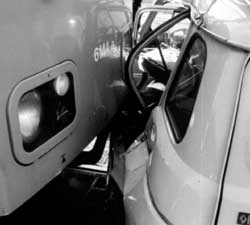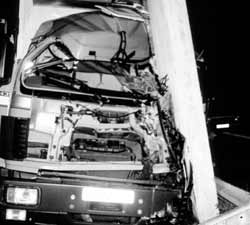German physicians go mobile to treat road crash victims
Trauma facility near the autobahn dispatches doctors to crash sites to document and treat injuries.
 For trauma and orthopaedic surgeons at
Hannover Medical School, treating vehicular trauma victims begins literally at
the point of impact.
For trauma and orthopaedic surgeons at
Hannover Medical School, treating vehicular trauma victims begins literally at
the point of impact.
“The trauma surgeons go directly to the accident scene and perform preclinical treatment and rescuing of road trauma patients [on site],” said Christian Krettek, MD, FRACS, who serves as the trauma center director and a professor at the medical school.
The trauma center has 40 surgeons overseeing 115 beds, including a nine-bed intensive care unit (ICU), operating room and clinics. The surgical staff, in addition to the head surgeon, includes 26 residents, seven attendings, four trauma fellows and two research fellows.
The center includes areas for ambulances, a paramedic helicopter and vehicles for the trauma surgeons, who begin preclinical treatment along with rescue measures at the accident scenes, Krettek said.
Importance of location
With two primary arteries of Germany’s autobahn near Hannover, the trauma unit is in prime position to respond to vehicle collisions, assist in rescue efforts and perform research that could help save lives.
|
COURTESY OF CHRISTIAN KRETTEK |
About 6000 collisions occur each year in the Hannover area, and half of the approximately 14,000 patients (10,000 outpatients, 4000 inpatients) treated annually at the trauma center are vehicular trauma victims. The staff performs about 3000 operations each year.
Founded in 1970 by Harald Tscherne, MD, the trauma center also features an accident research unit, which assembles teams to investigate crashes at the scene as soon as possible.
“These teams arrive promptly at the accident in their own vehicles following notification from police dispatchers,” Krettek said.
Backed by the road safety institute Bundesamt fur Strassenwesen (BASt), which is under the German Ministry of Transport, Building and Housing, the research unit has documented about 1000 vehicle collisions a year since 1988.
The research unit compiles comprehensive files on each case, including the details of the injuries, photographs of the collision scene (inside and outside the vehicles), relevant radiographic films and interviews with the surgical team, Krettek said.
The research unit, which consists of trauma and orthopaedic surgeons, nurses and other staff, scrutinize collision details with the help of an engineer, and the team performs its own accident reconstruction with the information.
|
|
Facing the challenges of polytrauma
While patients with multiple traumas from vehicle collisions and other incidents are typical at the trauma center, making decisions regarding fracture treatment or ICU admission can still be difficult.
“For example, since a patient with severe chest trauma should not be operated on initially for several hours, quick stabilization of fractures with external fixation is done so that the general condition of the patient can be stabilized in the ICU before fracture treatment takes place,” Krettek said.
Injury severity is classified according to the Abbreviated Injury Scale (for individual wounds), the Injury Severity Score (for multiple injuries) and the Hannover Polytrauma Score. A new polytrauma outcome score (HASPOC) was recently developed, which includes a self-report scale and a standardized head-to-toe physical examination.
Fighting infections
The most common orthopaedic complications of road trauma are infections to open injuries, such as fractures, which are treated immediately by surgery with debridement and irrigation, Krettek said.
Other problems in trauma care include life-threatening non-orthopaedic injuries like thoracic wounds and severe trauma of the spine, pelvis or long bones. General life-threatening conditions are treated in the ICU, while unstable fractures are stabilized operatively before ICU admission.
Concerning the pathophysiologic and pulmonary complications following reaming the femoral canal, the trauma surgeons at Hannover follow a more restrictive protocol for orthopaedic damage control, he said.




